Alexander Coosemans (1627-1689) stands as a significant, if sometimes under-documented, figure in the rich tapestry of 17th-century Flemish Baroque art. Specializing in still life painting, Coosemans carved a niche for himself with compositions brimming with luscious fruits, opulent flowers, and gleaming objects, all rendered with a meticulous attention to detail and a sophisticated understanding of light and texture. Born in Antwerp, a bustling artistic and commercial hub, he emerged during a golden age for still life painting in the Low Countries, a genre that captivated patrons with its blend of verisimilitude, symbolic depth, and sheer decorative beauty. His works not only reflect the technical prowess of the Antwerp school but also offer a window into the era's burgeoning global trade, scientific curiosity, and aesthetic sensibilities.
Early Life and Artistic Formation in Antwerp
Born in Antwerp in 1627, Alexander Coosemans entered a world where art was deeply interwoven with the city's identity and economy. Antwerp, despite political and economic shifts, remained a vibrant center for artistic production, particularly renowned for its painters. The Guild of Saint Luke, the city's powerful artists' guild, regulated the training and practice of painters, sculptors, and other craftsmen, ensuring high standards of quality and fostering a competitive yet collaborative environment. It was within this milieu that Coosemans would receive his formative artistic education.
A pivotal moment in Coosemans' early career occurred in 1641 when he was registered as a pupil of Jan Davidszoon de Heem (1606-1684). De Heem, though Dutch by birth, was active in Antwerp for significant periods and was one of the most celebrated and influential still life painters of his time. His works are characterized by their elaborate compositions, rich colors, and exquisite rendering of diverse textures – from the dewy skin of fruit to the reflective surfaces of glass and metal. De Heem's mastery in depicting sumptuous displays, often laden with symbolic meaning, undoubtedly left a profound impact on his young apprentice. Learning under such a distinguished master provided Coosemans with a strong foundation in the techniques and thematic concerns of high Baroque still life.
Attainment of Mastery and Italian Sojourn
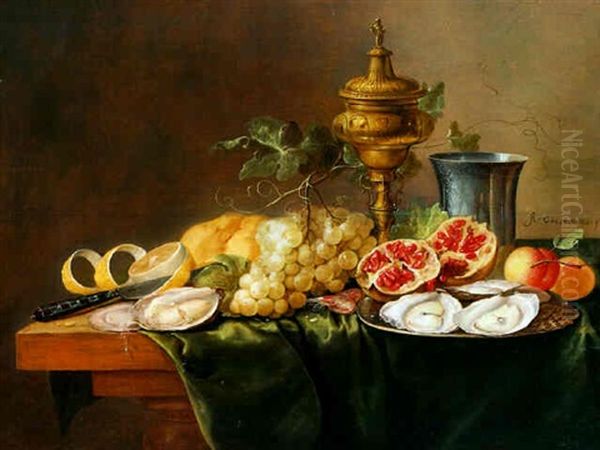
After several years of dedicated study under Jan Davidszoon de Heem, Alexander Coosemans achieved a significant milestone in his career. In 1645, at the remarkably young age of eighteen, he was accepted as an independent master into the Antwerp Guild of Saint Luke. This recognition signified that he had attained the requisite skill and artistic maturity to practice as an independent artist, take on his own pupils, and sell his works. Becoming a master so young speaks to his prodigious talent and the quality of his training.
A few years later, around 1649, Coosemans embarked on a journey to Italy, a common practice for ambitious Northern European artists seeking to broaden their artistic horizons and study firsthand the masterpieces of classical antiquity and the Italian Renaissance and Baroque. He is documented as being in Rome, the artistic epicenter of Europe at the time. While specific details of his interactions and the artists he may have directly engaged with in Rome are not extensively recorded, the experience of being immersed in the Italian artistic environment would have been invaluable. He would have encountered the dramatic naturalism of Caravaggio's followers, the classical compositions of the Bolognese school, and the burgeoning High Baroque style. This exposure likely refined his understanding of composition, color, and the dramatic use of light. Coosemans returned to his native Antwerp by 1651, where he re-registered with the Guild of Saint Luke, his artistic vision undoubtedly enriched by his Italian experiences.
The Distinctive Style of Alexander Coosemans
Alexander Coosemans developed a distinctive artistic style that, while rooted in the Flemish tradition and clearly influenced by his master Jan Davidsz. de Heem, possessed its own unique characteristics. His oeuvre primarily consists of still lifes featuring fruit and flowers, often complemented by other objects such as pewter plates, glassware, and occasionally, more exotic items that reflected Antwerp's status as a port city with global trade connections.
A hallmark of Coosemans' work is his meticulous rendering of detail. He paid close attention to the varied textures of his subjects: the velvety bloom on a peach, the translucent gleam of grapes, the rough rind of a melon, or the cool, smooth surface of a pewter dish. This tactile quality was achieved through careful brushwork and a keen observation of how light interacts with different materials. His compositions are often abundant and complex, yet carefully balanced, creating a sense of opulent naturalism.
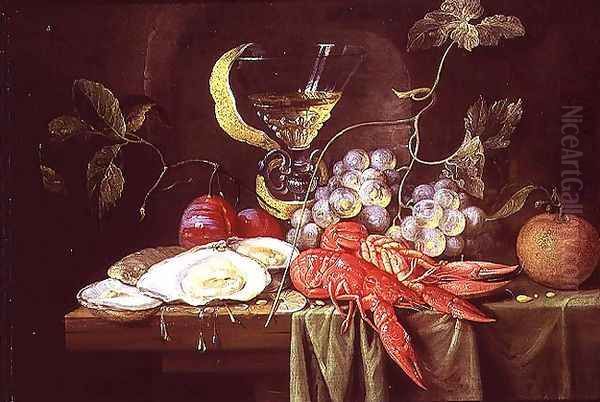
Coosemans was a skilled colorist, employing a rich and vibrant palette. His fruits and flowers glow with an inner light, their hues ranging from deep reds and purples to bright yellows and greens, often set against darker, atmospheric backgrounds that enhance their luminosity. The interplay of light and shadow (chiaroscuro) is a key feature, used not only to model forms and create a sense of three-dimensionality but also to add drama and focus to his compositions. While many of his works celebrate abundance and the beauty of nature, some pieces also exhibit a more melancholic or romantic tendency, perhaps hinting at the transience of earthly beauty, a common underlying theme in vanitas still lifes of the period.
Thematic Concerns and Subject Matter
The subject matter chosen by Alexander Coosemans aligns closely with the prevailing tastes of the 17th-century art market, particularly for still life. His most frequent subjects were arrangements of fruit, often depicted with a striking degree of realism that made them appear almost tangible. Grapes, peaches, plums, cherries, melons, pomegranates, and citrus fruits feature prominently, their varied shapes, colors, and textures providing ample opportunity for the artist to showcase his technical virtuosity. These fruits were not merely decorative; they often carried symbolic meanings related to abundance, fertility, the seasons, or even religious concepts, though Coosemans' work tends to emphasize their sensuous appeal.
Flowers also appear in his compositions, sometimes as the primary subject and at other times complementing fruit arrangements. Like fruits, flowers allowed for a display of brilliant color and delicate form. The inclusion of specific blooms could also carry symbolic weight, a visual language understood by contemporary audiences. Roses, tulips, lilies, and carnations were popular choices, each with its own associated meanings.
Beyond fruit and flowers, Coosemans occasionally incorporated other elements into his still lifes. Metalware, such as pewter plates or silver ewers, provided a contrast in texture and allowed the artist to demonstrate his skill in rendering reflective surfaces. Glassware, filled with wine or water, offered similar challenges and opportunities. The inclusion of exotic items, such as imported fruits or shells, hinted at the expanding world known to Europeans through trade and exploration, adding a touch of the novel and luxurious to his paintings. These compositions, often referred to as pronkstilleven (sumptuous or ostentatious still lifes), were particularly popular among wealthy burghers who wished to display their prosperity and sophisticated taste.
The Enduring Influence of Jan Davidsz. de Heem
The impact of Jan Davidsz. de Heem on Alexander Coosemans' artistic development cannot be overstated. De Heem was a towering figure in still life painting, renowned for his ability to combine meticulous detail with a sense of lavishness and vitality. His influence on Coosemans is evident in several aspects of the younger artist's work.
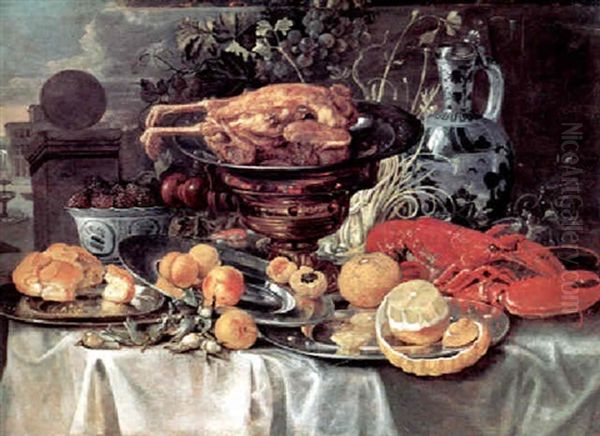
Firstly, the choice of subject matter – opulent arrangements of fruits, flowers, and precious objects – clearly echoes De Heem's own preferences. De Heem excelled at creating complex, richly populated scenes, and Coosemans adopted a similar approach, often filling his canvases with a cornucopia of natural and man-made items. The emphasis on creating a sense of abundance and material richness is a shared characteristic.
Secondly, De Heem's technical mastery, particularly his ability to render diverse textures and the effects of light, served as a direct model for Coosemans. The way Coosemans captures the sheen on a grape, the fuzz on a peach, or the reflection in a glass vessel owes much to De Heem's pioneering techniques. Both artists shared a commitment to verisimilitude, making their painted worlds incredibly lifelike.
However, while Coosemans absorbed many lessons from his master, he was not a mere imitator. He developed his own artistic personality, sometimes favoring slightly less cluttered compositions or a particular mood. His Italian sojourn may also have introduced nuances to his style that differentiated him from De Heem, whose own influences were primarily rooted in the Dutch and Flemish traditions. Nevertheless, the foundation laid by De Heem provided Coosemans with the tools and the artistic vocabulary to become a respected still life painter in his own right. Other artists who were pupils or followers of De Heem, such as Abraham Mignon, also demonstrate the widespread impact of his style, creating a distinct lineage within Baroque still life.
Coosemans in the Context of Flemish and Dutch Still Life
To fully appreciate Alexander Coosemans' contribution, it is essential to view his work within the broader context of still life painting in the Low Countries during the 17th century. This period witnessed an unprecedented flourishing of the genre, with artists in both the Southern Netherlands (Flanders, where Antwerp is located) and the Northern Netherlands (the Dutch Republic) producing a vast number of still lifes of remarkable quality and diversity.
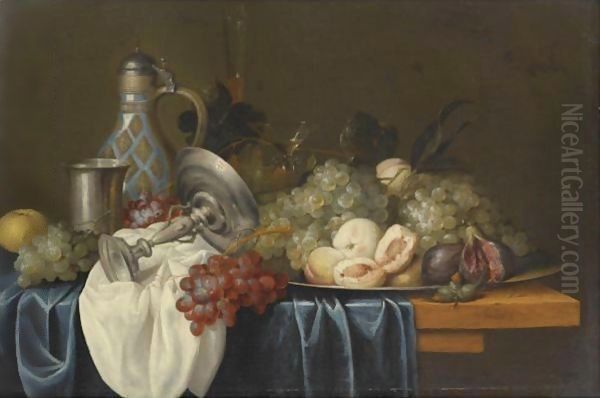
In Flanders, artists like Frans Snyders (1579-1657) and Adriaen van Utrecht (1599-1652) were known for their large-scale, dynamic still lifes, often featuring game, elaborate market scenes, and collaborations with figure painters like Peter Paul Rubens and Jacob Jordaens. Osias Beert the Elder (c. 1580-1623/24) was an earlier pioneer, creating more formally arranged breakfast pieces and flower paintings. Clara Peeters (1594-c. 1657), one of the few prominent female painters of the era, also made significant contributions to early Flemish still life with her detailed depictions of food, flowers, and precious objects. Jan Brueghel the Elder (1568-1625) was highly esteemed for his exquisite flower paintings, often imbued with encyclopedic detail. Daniel Seghers (1590-1661), a Jesuit painter, specialized in flower cartouches surrounding religious scenes or portraits. Coosemans' work, while sharing the Flemish love for rich detail and vibrant color, generally focused on more intimate, though still opulent, arrangements compared to the grander scale of Snyders.
In the Dutch Republic, still life painting also thrived, with distinct subgenres emerging. Willem Claesz. Heda (1594-1680) and Pieter Claesz (1597-1660) were masters of the "monochrome banketje" (monochromatic banquet piece), characterized by subtle color harmonies and carefully arranged table settings. Willem Kalf (1619-1693) became famous for his pronkstilleven, similar in spirit to those of De Heem and Coosemans, featuring luxurious items like Chinese porcelain, Turkish carpets, and silver. Flower painting reached extraordinary heights with artists like Rachel Ruysch (1664-1750) and Jan van Huysum (1682-1749), though they belong to a slightly later generation. Abraham van Beyeren (c. 1620-1690) was versatile, painting lavish banquet pieces as well as dramatic scenes of fish.
Coosemans, working in Antwerp but clearly aware of developments across the Low Countries (especially through his Dutch master De Heem), navigated these currents. His style often blends the richness associated with Flemish painting with the meticulous realism prized in both regions. His trip to Italy also potentially exposed him to the still life traditions there, perhaps influencing his use of light and shadow, reminiscent of the tenebrism popularized by Caravaggio (1571-1610) and his followers, though Coosemans' application is generally less stark.
Notable Works and Their Characteristics
While a comprehensive catalogue raisonné of Alexander Coosemans' work is complicated by the fact that not all his paintings were signed, several attributed pieces showcase his characteristic style and skill. Among his recognized works, paintings like "Still Life with Fruit and Pewter Plate" and "Still Life: Fruit" are often cited.
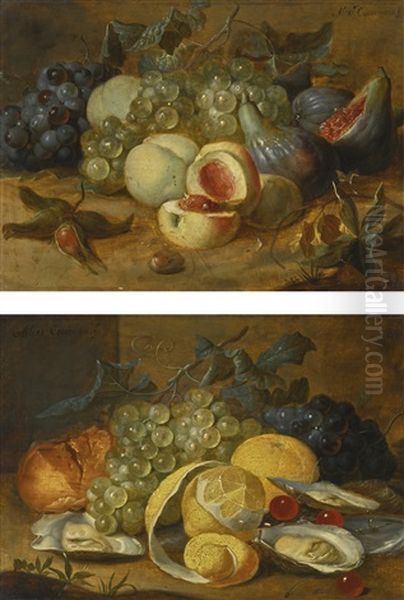
"Still Life with Fruit and Pewter Plate" would typically exemplify Coosemans' ability to create a harmonious composition from diverse elements. Such a painting would likely feature an array of meticulously rendered fruits – perhaps grapes, peaches, a cut melon revealing its vibrant flesh, and figs – arranged artfully on or around a pewter plate. The choice of a pewter plate is significant; its matte, silvery surface would provide a subtle contrast to the rich colors and varied textures of the fruit, and Coosemans would have skillfully captured the dull gleam of the metal. The interplay of light would be crucial, highlighting the ripeness of the fruit and creating soft shadows that add depth to the scene. The overall effect would be one of controlled abundance and tactile realism.
"Still Life: Fruit," a title that could apply to many of his works, underscores his primary thematic focus. A painting with this title, such as the one noted to be in the Groninger Museum (Groningen, Netherlands), would likely showcase a similar dedication to naturalistic detail. One might expect to see a variety of fruits, perhaps including exotic additions like a pomegranate or a partially peeled lemon, its spiraling rind a common motif in still lifes of the period, allowing artists to display their skill in rendering complex forms and textures. The composition would likely be rich and inviting, with colors that are both vibrant and harmonious. The background would typically be subdued, ensuring that the viewer's attention remains focused on the sumptuous display of fruit.
Other works attributed to Coosemans often feature similar elements: baskets overflowing with fruit, arrangements of flowers in glass or ceramic vases, and sometimes the inclusion of insects like butterflies or snails, which could add a layer of vanitas symbolism (the fleeting nature of life) or simply enhance the naturalism of the scene. His paintings in the Reiss Engelhorn Museum in Mannheim would further attest to his skill in these areas. The consistent quality in the rendering of light, texture, and color across these attributed works helps to define his artistic identity.
Challenges in Attribution and Artistic Legacy
One of the challenges in fully assessing Alexander Coosemans' oeuvre and his precise place in art history is the relative scarcity of signed and dated works. This is not uncommon for artists of the period, but it does mean that attributions often rely on stylistic analysis and comparison with securely identified pieces. The lack of extensive contemporary documentation about his life and workshop practices further complicates scholarly research.
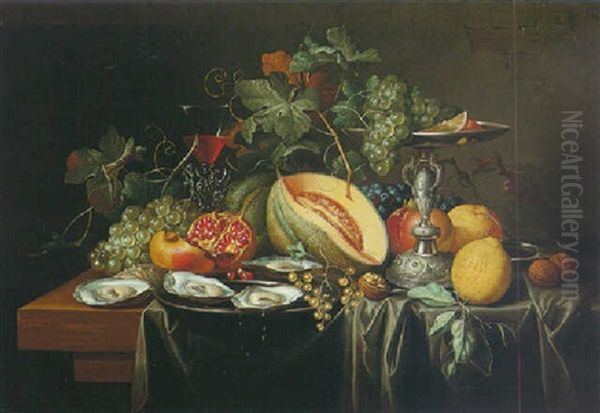
Despite these challenges, Coosemans' artistic legacy is secured by the quality of the works attributed to him. He is recognized as a skilled practitioner of the Flemish Baroque still life, a painter who successfully absorbed the lessons of his renowned master, Jan Davidsz. de Heem, while also developing his own nuanced approach. His paintings are valued for their aesthetic appeal, their technical proficiency, and their contribution to the rich tradition of still life painting in 17th-century Antwerp.
His works reflect the cultural preoccupations of his time: an appreciation for the beauty of the natural world, the display of wealth and sophisticated taste through the depiction of luxurious items, and perhaps an underlying awareness of the transience of earthly pleasures. The inclusion of exotic fruits and objects in some of his paintings also speaks to Antwerp's role as a center of international trade, bringing goods from distant lands to the European market. These paintings served not only as decorative items but also as conversation pieces and status symbols for their owners.
Coosemans' paintings continue to be appreciated in public and private collections. Their presence in museums like the Groninger Museum and the Reiss Engelhorn Museum, and their appearance in exhibitions, such as the one noted at the Queensland Art Gallery, ensure that his work remains accessible to contemporary audiences. Art historians continue to study his paintings, seeking to refine attributions and to better understand his specific contributions to the evolution of still life.
Coosemans' Enduring Place in Art History
Alexander Coosemans occupies a respected position within the constellation of 17th-century Flemish still life painters. While perhaps not as widely known today as some of his contemporaries like Frans Snyders or his master Jan Davidsz. de Heem, his work consistently demonstrates a high level of artistic skill and a refined aesthetic sensibility. He was a master of capturing the sensuous qualities of fruits and flowers, rendering their textures, colors, and the play of light upon their surfaces with remarkable fidelity.
His contribution lies in his ability to create compositions that are both opulent and harmonious, inviting the viewer to delight in the beauty of the depicted objects. His paintings are a testament to the enduring appeal of still life, a genre that allowed artists to explore the nuances of form, color, light, and texture in intimate detail. They also reflect the cultural values of his era, celebrating abundance and the wonders of the natural world, while sometimes subtly hinting at deeper symbolic meanings.

The journey from his apprenticeship under a leading master, through his attainment of independent mastery at a young age, to his enriching experiences in Italy, all shaped him into a distinctive artistic voice. Even with the challenges posed by attribution, the body of work associated with Alexander Coosemans reveals an artist dedicated to his craft, capable of producing still lifes of considerable beauty and technical sophistication. He remains an important figure for understanding the depth and diversity of Baroque art in Antwerp and the broader tradition of still life painting in the Low Countries. His luminous depictions of nature's bounty continue to captivate viewers, securing his place in the annals of art history.